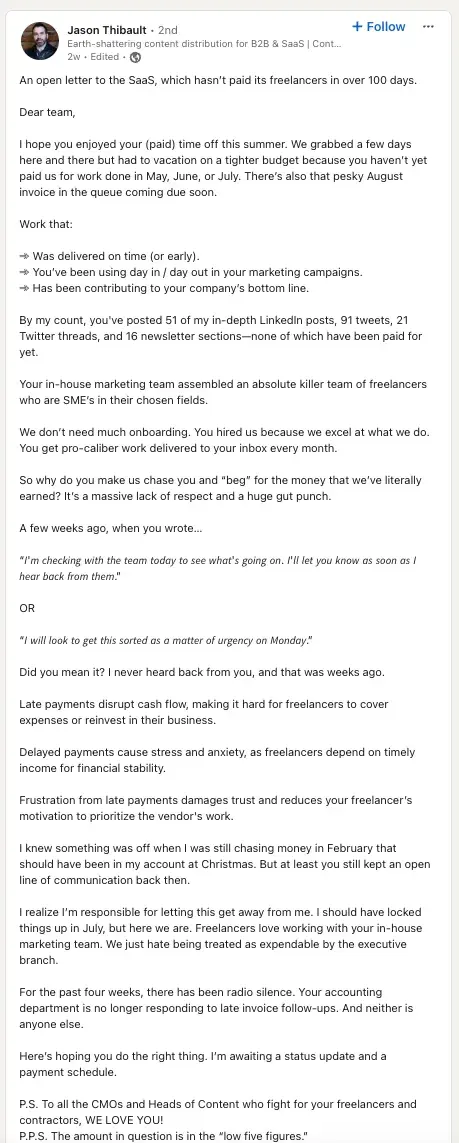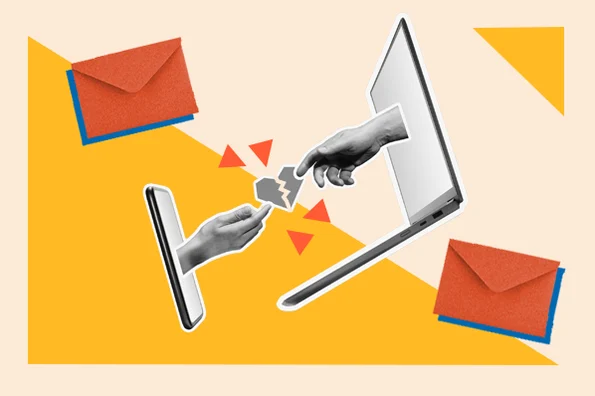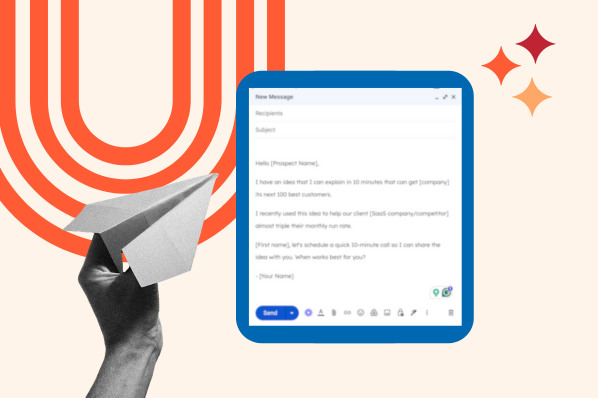One way I prevent a repeat of this ugly situation is by having a contract and using payment reminder email templates. These templates save me time and keep me professional while ensuring clients stay accountable.
Table of Contents
- Why Is Sending a Payment Reminder Email So Painful?
- How to Get Over the Fear of Asking for Payment
- How to Ask for Payment Professionally
- Payment Reminder Email Templates
- Preventing Payment Conflicts
Why Is Sending a Payment Reminder Email So Painful?
Sending a payment reminder email feels like walking on eggshells. It’s awkward, frustrating, and draining. I recall one time I had to send several follow-up emails before getting paid after two weeks. It was brutal!

In today’s inflation-ridden world, waiting for payment isn’t just inconvenient — it’s stressful. My landlord doesn’t care that a client is late for payment. Neither do insurance companies or the subscriptions that hit my account month after month. Chasing down payments, on top of everything else, is infuriating.
For the client I mentioned above, I had to tread carefully. I didn’t want to damage the relationship I worked so hard to build or jeopardize future projects and referrals. This balancing act is one that 59% of freelancers — who are collectively owed $50,000 or more in late payments — know all too well. Defaulting clients force these freelancers to decide between keeping the peace or pushing harder for payment and risk losing them. It’s bizarre!
The worst part isn’t just the money — it’s the mental toll. Each follow-up email is a reminder that time is slipping away. And as the odds of losing the money increase, your anxiety could spike, impacting your ability to deliver superb work on your current projects.
How to Get Over the Fear of Asking for Payment
Asking for a payment can feel intimidating, especially for freelancers and contractors who have less skin in the game. I remember when I was still hustling on a freelance platform. I delivered a project, and the client didn’t pay. To avoid coming off as pushy, I sent professional email reminders.
The response? None.
I had to find the details of this client online and gave him a — surprise-surprise 😁 — call. After getting the payment, I felt relieved. But you know what I learned? The need for a contract.
Once you and a client sign a contract, you deliver the work and the client pays. Getting paid is simply a part of the agreement. This mindset shift lets you view payment requests as business communication, not a confrontation. My contract outlines expectations upfront, so when the time for payment comes, requesting or getting it without asking is a natural next step.
Another way I get over the fear of asking for payment is by detaching my emotions from the situation. I discard thoughts like:
- “I don’t want to lose this client.”
- “What if they think I’m being difficult?”
- “Won’t I appear ungrateful for their business?”
These thoughts should not stop me (or you!) from sending crucial follow-up emails. It’s a business relationship and both parties have to honor their part.
Think about it: Many clients won’t shy from venting their frustration if you miss a deadline or deliver a project that misses the mark. Is this acceptable? 100%. And as the idiom goes, “What is good for the goose is good for the gander.” So if a client can vent, you can as well — provided you stick to professional, polite language.
The bottom line about requesting your payment is that it’s just business; when you see it this way, the fear of asking for your hard-earned money disappears.
How to Ask for Payment Professionally
Being proactive is what gets you paid. Here are seven ways to ask for your payment while keeping communication professional. I recommend considering them in the order I presented since they’re intended to help you escalate payment issues step by step.
1. Start asking early.
Never wait until the due date before sending your invoice.
For instance, once I complete a client's project, I send both the deliverables and my invoice with a polite message.
By setting expectations early, I let the client know that payment is part of the workflow and not an afterthought. That said, keep things organized — a simple spreadsheet will do. While you’re at it, also set up invoice templates dedicated to each client. This spares you the hassle of rewriting the clients’ details every time you create an invoice. Free tools like HubSpot’s Invoice Generator are perfect for this.
2. Send a reminder a few days before the due date.
There was a certain client I worked with for months and I never thought he'd slip up on paying.
Newsflash: He did.
I don't entirely fault this client because he might have gotten busy, forgot to schedule the payment, or didn’t put a reminder in his calendar.
Reasons like these necessitate a payment reminder email a few days before the due date. This email is a subtle but effective way to nudge clients to prioritize your payment. It also lets them flag potential payment issues before the due date.
3. Send a DM.
Direct messaging (DMs) on LinkedIn or other professional channels might be effective if emailing fails. DMs are most useful when you know the client is active on such platforms.
Always keep the message professional, avoiding a casual or overly informal tone.
4. Try a phone call.
Email reminders may fall on deaf ears and direct messages may not get a response. When this happens, don't conclude that the client is about to ghost you and unleash a tirade of unprofessional communication.
Such a client might be sick, have a pressing family issue, took a pregnant wife to the hospital, or have other personal challenges.
In such situations, a polite phone call lets you clarify the client's challenges so you can know what to do and speed up the payment process.
5. Consider unconventional options.
Emails, DMs, and phone calls are traditional ways of making contact professionally.
If they fail, odds are the client is about to ghost you or may have a serious financial challenge, which is preventing them from paying.
To get your money, you need to be creative and daring while maintaining professionalism.
Jason Thibault, a content distribution specialist, shared a brilliant example of this approach that I like. Notice that as painful as the situation was, Jason refrained from naming the client — that’s professionalism at its finest.

6. Revoke access to deliverables.
If you don’t get your payment after applying the above steps, you might need to withdraw the client’s access to the deliverables.
Withholding access to deliverables might prompt swift client action. However, professionally communicate this in one of your reminder emails before taking this step.
Sometimes, you could revoke access and find that the client continues using your work.
If that happens, contact other persons within the company to flag this issue and request for your payment. If there’s no response and you are positive they’ve seen your messages, you’d need to call them out online for a small payment. For a sizeable amount, it’s best to follow the legal route.
7. Try the legal pathway for sizeable amounts.
If the payment is significantly overdue, and the amount is large, consider the legal route.
Before escalating, your final payment reminder email should inform the client that you will take legal action if the invoice remains unpaid after a certain time.
Once the time elapses, you could use a small claims court or get the service of a debt collection agency. Using a lawyer will cost you and debt collection agencies charge 20% or more of the owed amount. As much as possible, I’d avoid going down the legal route and use it as a last resort to avoid losing money.
Payment Reminder Email Templates
Below are eight payment reminder email templates which align with the tips for asking for your payment professionally.
Automating these emails with a free CRM can save time and let you know if the client opens your emails. The challenge is that a client might open your email and not pay. As such, I create reminders in my calendar to follow up if I don’t receive the payment. Once I receive the payment, I stop the automation.
If you need more payment reminder email templates, you can get inspiration from our email templates or use the HubSpot email copy generator.
Payment reminder email template 1: Send after concluding the project.
Email subject line: Project Completed–Invoice [#] Attached
Hi [Client's Name],
I’m excited to let you know that I’ve completed the assigned project. It’s been a pleasure working on [project name], and I hope you’re as happy with the results as I am.
Attached is the invoice for the total amount of [amount]. As per our agreement, the payment is due by [due date]. Please let me know if you have questions, and reach out if you need any help.
Looking forward to working with you again!
Best regards,
[Email signature]
Payment reminder email template 2: Send three days before the due date.
Email subject line: Invoice [#] Due Soon
Hi [Client's Name],
Just a quick reminder that the payment for [project name] is due in three days, on [due date].
If you need the invoice re-sent or have questions, let me know. Thank you so much for attending to this!
Best regards,
[Email signature]
Payment reminder email template 3: Send on the payment due date.
Email subject line: Invoice [#] due today
Hi [Client's Name],
I wanted to remind you that payment for the completed [project name] is due today. I’ve attached the invoice once more.
Please let me know once you’ve processed the payment. I’m happy to help if you have questions or require assistance.
Thank you for your cooperation.
Best,
[Email signature]
Payment reminder email template 4: One day late.
Email subject line: Invoice [#] overdue by one day
Hi [Client's Name],
I wanted to remind you that payment for [project name] was due yesterday. I’ve reattached the invoice for your reference.
Could you let me know once you’ve processed the payment?
Please reach out if you have questions.
Thank you for your cooperation.
Best,
[Email signature]
Payment reminder email template 5: One week overdue.
Email subject line: Friendly Reminder–Invoice [#] Past Due Date
Hi [Client's Name],
I hope you’re doing well! I’m following up on the invoice for [project name], which was due on [due date]. It appears the payment hasn’t been processed yet.
Could you kindly let me know when I can expect the payment? If there has been any issue or delay on your end, reach out and I’ll do my best to assist.
Thank you attending to this!
Best regards,
[Email signature]
Payment reminder email template 6: Two weeks overdue.
Email subject line: Unpaid Invoice [#] is 2 Weeks Overdue
Hi [Client's Name],
I wanted to check in again regarding the outstanding payment for [project name]. The invoice was due on [due date], and it’s now two weeks past due.
I understand things can get busy, so I wanted to kindly ask for an update on when you will process the payment. If there’s anything I can do to facilitate this, please let me know.
Your prompt attention to this would be appreciated.
Best regards,
[Email signature]
Payment reminder email template 7: One month overdue.
Email subject line: Urgent: Payment Overdue–Invoice [#]
Hi [Client's Name],
I hope all is well. I’m writing to remind you that the payment for [project name], due on [due date], is now one month overdue. This is an urgent matter, and I’d appreciate it if you could prioritize this payment.
Please let me know immediately when you will process the payment or if there’s any issue I should know. I’m happy to help resolve this.
Thanks in advance for your cooperation.
Best,
[Email signature]
Payment reminder email template 8: Five weeks overdue.
Email subject line: Final Notice: Invoice [#] Overdue–Immediate Action Required
Hi [Client's Name],
This is my last reminder regarding the payment for [project name], which was due on [due date]. The invoice is now 5 weeks overdue, and I have not received a response or payment.
Please be advised that if I do not receive the payment by [new deadline, e.g., 3 days from now], I will have no choice but to pursue further actions such as legal steps to recover the owed amount.
I strongly encourage you to resolve this matter immediately to avoid any further complications.
Thank you for your prompt attention.
Sincerely,
[Email signature]
Preventing Payment Conflicts
It’s better to prevent payment conflicts than to fix them. Someone who learned this the hard way is Lizi Guest, the founder of a PR consultancy.
Lizi Guest is tenacious. I was awestruck when I learned she chased a payment for 12 entire months! According to Lizi, she texted, emailed, and called. Lizi also considered writing off the payment and couldn’t use a lawyer or debt collection agency. I‘m happy for Lizi because she’s hopeful about receiving a full payment. But what’s even more vital are Lizi’s valuable lessons for preventing future payment conflicts.

After this experience, Lizi updated her company’s contracts, made sure every variation was in writing, and also now requests deposits from all new clients. Now, Lizi says she trusts her guts when a client might not be the best fit. She also talks to clients often about invoices and offers flexible payment terms in case they have unexpected difficulties.
I think Lizi’s points are great. However, an important consideration is to include a late payment fee in your contract. This will discourage clients from delaying payments since they know they must abide by the contract terms and pay you on time.
With your contracts in tip-top shape — and tips and templates in hand for how to ask for payment professionally — you’re well on your way to a positive invoicing experience.
Email Templates








.jpg)

![What to Do When Your Prospect Ghosts [Free No-Show Follow-Up Email Templates]](https://53.fs1.hubspotusercontent-na1.net/hubfs/53/no-show-prospects-templates_3.webp)

